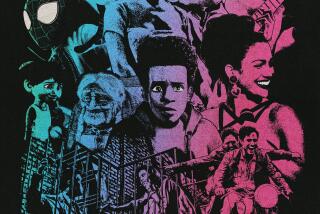Jose Greco; American Dancer Popularized Spanish Culture, Founded Flamenco Dynasty
- Share via
Jose Greco, the Italian-born American dance star and choreographer who brought traditional Spanish culture to unprecedented popularity in the 1950s and ‘60s, has died.
Greco died Sunday at his home in Lancaster, Pa. He was 82. A representative of Franklin and Marshall College, where Greco was an adjunct professor, attributed his death to heart failure.
In a career that included performances on Broadway, the concert stage, film and television, Greco not only carved out a niche for himself in the forbiddingly insular world of Spanish dance, he founded a flamenco dynasty: During the last decade, his son, Jose II, and his daughters, Lola and Carmela, have won renown in the contemporary flamenco community for their innovative dancing and choreography.
Summarizing the stature of Greco Sr. in The New Yorker magazine, dance critic Arlene Croce noted that “the undisputed Spanish dance star of the ‘50s and ‘60s was Jose Greco; in terms of box-office power he may have been the greatest of all dance stars until the advent of Rudolf Nureyev.”
This success proved all the more remarkable because Greco was not Spanish, much less a Gypsy, and had to fight entrenched xenophobia in the flamenco world.
Born Constanzo Jose Greco on Dec. 23, 1918, in Montorio nei Frentani, Italy, he moved to Seville, Spain, at age 3 and then came to the United States when he was 8, living with his family in Brooklyn.
He studied Spanish dance in his teenage years with Helen Veola and made his debut as a performer at the New York Hippodrome in the operas “La Traviata” and “Carmen” in 1935. He also appeared as a specialty dancer in New York nightclubs for a number of years before the great Spanish dance star La Argentinita invited him to join her company in the early 1940s.
“The turning point for me and for all of us, came in January 1943,” Greco told The Times 43 years later. “The Marquis de Cuevas organized a homage to [poet] Garcia Lorca as a benefit for the Museum of Modern Art, which was to encompass all phases of Spanish art. [Painter] Salvador Dali and [classical pianist] Jose Iturbi participated, among others. La Argentinita’s company was included. It was such a success it was repeated at the Met in May. [Impresario Sol] Hurok saw the benefit of a full company, not just an ensemble.
“I owed Hurok a lot in more ways than one,” Greco recalled. “He kept me out of the Army. He went to the draft board and persuaded them that I was more useful touring hospitals and Army bases than carrying a gun.”
Reviewing Greco in 1945, when he danced in the company of La Argentinita, the distinguished American dance critic Edwin Denby wrote that “Jose Greco, elegant and suave, has become a limpid virtuoso. To my mind, he is still too consistently easy in the torso, and too consistently light on his feet, but the continuity of his dancing and the exactness of his gesture and his steps were very fine indeed.”
After La Argentinita’s death that same year, Greco went to Spain with her sister, dancer Pilar Lopez. In 1947, he formed his own company, touring Europe before bringing the troupe to America at the end of 1950. From the first, his popularity proved unmatched. His was the first Spanish dance company to ever have a run on Broadway and it attracted 10,000 spectators to Lewisohn Stadium in New York for one of its performances. From Greco’s return to America, he never stopped touring until 1969 and was told his company grossed $14 million in those two decades.
His feature films included “Manolete” (1948), “Sombrero” (1953), “Around the World in 80 Days” (1956), “Holiday For Lovers” (1959), “Ship of Fools” (1965) and “The Proud and the Damned” (1968). He also appeared on a number of television variety shows in the 1950s and ‘60s. He was knighted by the Spanish government in 1962.
Greco officially retired in 1974 and his autobiography, “Gypsy in My Soul,” was published in 1977. However, he continued to give sporadic performances, including several in Southland venues: the Wilshire Ebell Theatre, for instance, in 1986 (as a guest with the Maria Benitez Spanish Dance Company), and the Ambassador Auditorium in Pasadena in 1993 (with Jose Greco II).
Such appearances did not always enhance his stature. A review by this writer in 1986 noted that, “At 67, Jose Greco is no longer Jose Greco. One of the great bodies in dance--sinewy, resilient, nobly proportioned--has become top-heavy and tightly corseted, incapable of the elegant line and expressive freedom that used to define Greco as an artist . . . but he reminded his fans of his refined footwork, polished cape (or shawl) manipulation and his remarkable concentration.
“But if Greco never again lives up to his reputation,” the review concluded, “he will certainly never outlive it: He is too important in the history of male dancing in America (and Spain, of course) to be forgotten or diminished.”
Besides his professional accomplishments, Greco married three times and fathered six children. In a Times interview in 1986, he looked back with special pleasure on how he forced Spaniards to reconsider their belief that nobody else could dance flamenco.
“They couldn’t believe I wasn’t Spanish,” he said, recalling his first appearances in Madrid with Lopez and her Ballet Espanol in 1946. “They just dismissed the idea that an Italian from Brooklyn could master this Spanish art form. No one had ever done it before and they thought I was lying.”
He outlived the disbelief and also all the nasty nicknames assigned him (“El Chevalito de Brooklyn,” for instance), leaving his dancing offspring not only a standard of excellence, but a flamenco world in which the dancing is all that matters.
“I’ve never regretted the road I took,” Greco said. “I realized it one day in a very special way. I finally visited the village in Italy where I was born. I sat in the piazza with people who had known my family. It was picturesque, lovely. And suddenly I thought to myself, ‘What am I doing here? I don’t belong here. I am of Spain!’ ”
More to Read
The biggest entertainment stories
Get our big stories about Hollywood, film, television, music, arts, culture and more right in your inbox as soon as they publish.
You may occasionally receive promotional content from the Los Angeles Times.










